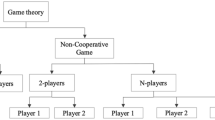Abstract
We analyze the “roundness level” of bids—defined as the number of zeros at the end of the bid—in public procurement auctions for construction works in Okinawa Prefecture, Japan, where a bid-rigging case was filed. We hypothesize that bid rigging increases the roundness of bids through the bid coordination process. Specifically, winners choose round numbers to avoid any miscommunication when they announce their planned bids to other ring members, and losers prefer round numbers when they arbitrarily bid above the winning bid. We find that (1) there is a positive relationship between the roundness of a bid and its relative value as a fraction of the reserve price, (2) the roundness of bids is higher when collusion is active than when it is inactive, (3) among the ring bids, the roundness of the lowest bids is even higher than that of the other bids, and (4) bids by non-ring members are also round when collusion is active.


Similar content being viewed by others
Notes
References
Abrantes-Metz, R. M., Froeb, L. M., Geweke, J. F., & Taylor, C. T. (2006). A variance screen for collusion. International Journal of Industrial Organization, 24, 467–486.
Anderson, E. T., & Simester, D. I. (2003). Effects of \(\$9\) price endings on retail sales: Evidence from field experiments. Quantitative Marketing and Economics, 1(1), 93–110.
Asker, J. (2010). A study of the internal organization of a bidding cartel. American Economic Review, 100(3), 724–762.
Bajari, P., & Ye, L. (2003). Deciding between competition and collusion. Review of Economics and Statistics, 85(4), 971–989.
Cramton, P., & Schwartz, J. A. (2000). Collusive bidding: Lessons from the FCC spectrum auctions. Journal of Regulatory Economics, 17(3), 229–252.
Cramton, P. & Schwartz, J. A. (2002). Collusive bidding in the FCC spectrum auctions. Contributions to Economic Analysis and Policy, 1, article 11.
Genesove, D., & Mullin, W. P. (2001). Rules, communication, and collusion: Narrative evidence from the sugar institute case. American Economic Review, 91(3), 379–398.
Ishii, R. (2008). Collusion in repeated procurement auction: A study of a paving market in Japan. ISER Discussion Paper No. 710, Institute of Social and Economic Research, Osaka University.
Ishii, R. (2009). Favor exchange in collusion: Empirical study of repeated procurement auctions in Japan. International Journal of Industrial Organization, 27(2), 137–144.
Kahn, C., Pennacchi, G., & Sopranzetti, B. (1999). Bank deposit rate clustering: Theory and empirical evidence. Journal of Finance, 54(6), 2185–2214.
Kandel, S., Sarig, O., & Wohl, A. (2001). Do investors prefer round stock prices? Evidence from Israeli IPO auctions. Journal of Banking and Finance, 25(8), 1543–1551.
Klumpp, J. M., Brorsen, B. W., & Anderson, K. B. (2007). Producers’ preferences for round number prices. Agricultural Finance Review, 67(2), 377–385.
Kreul, L. M. (1982). Magic numbers: Psychological aspects of menu pricing. Cornell Hotel and Restaurant Administration Quarterly, 23, 70–75.
Pesendorfer, M. (2000). A study of collusion in first-price auctions. Review of Economic Studies, 67(3), 381–411.
Porter, R. H. (1983). A study of cartel stability: The joint executive committee, 1880–1886. Bell Journal of Economics, 14(2), 301–314.
Porter, R. H., & Zona, J. D. (1993). Detecting of bid rigging in procurement auctions. Journal of Political Economy, 101(3), 518–538.
Roller, L.-H., & Steen, F. (2006). On the working of a cartel: Evidence from the Norwegian cement industry. American Economic Review, 96(1), 321–338.
Schindler, R. M., & Kibarian, T. M. (1996). Increased consumer sales response through use of 99-ending prices. Journal of Retailing, 72(2), 187–199.
Acknowledgments
I am grateful to Masaki Aoyagi, Kazuo Ogawa and Fumio Ohtake for helpful suggestions and discussions. I also thank seminar participants for comments. The comments of Lawrence J. White (Editor) and two anonymous referees were extremely useful in the revision process. Any errors are mine. This work was supported by JSPS Grant-in-Aid Numbers 22730204, 22243022.
Author information
Authors and Affiliations
Corresponding author
Rights and permissions
About this article
Cite this article
Ishii, R. Bid Roundness Under Collusion in Japanese Procurement Auctions. Rev Ind Organ 44, 241–254 (2014). https://doi.org/10.1007/s11151-013-9408-6
Published:
Issue Date:
DOI: https://doi.org/10.1007/s11151-013-9408-6




